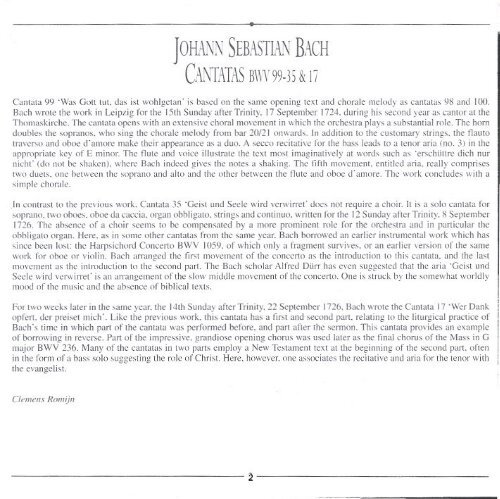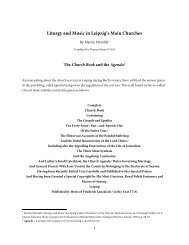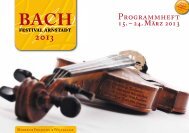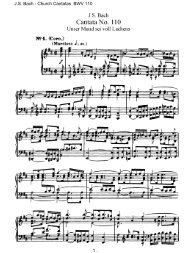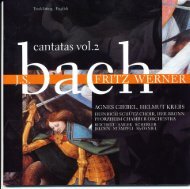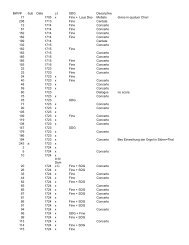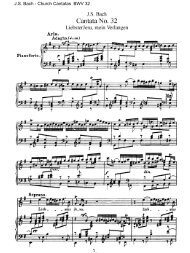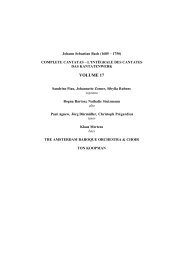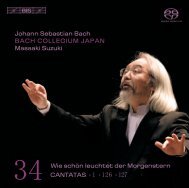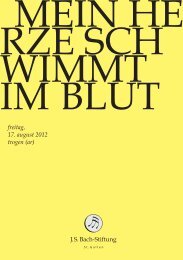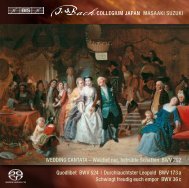Bach Cantatas, Vol. 3 - P.J. Leusink (Brilliant Classics 5-CD)
Bach Cantatas, Vol. 3 - P.J. Leusink (Brilliant Classics 5-CD)
Bach Cantatas, Vol. 3 - P.J. Leusink (Brilliant Classics 5-CD)
You also want an ePaper? Increase the reach of your titles
YUMPU automatically turns print PDFs into web optimized ePapers that Google loves.
JOHA.~\SEBASTIA.\J BACH<br />
C.lJYfATAS B\\Y99-35&17<br />
Cantata 99 'Was Gou (ut. das iSl wohlgctan' isbased on (hesmne opening text and chorale melody ascantatas98 and 100.<br />
<strong>Bach</strong> wrote the work in Lcip/.ig for the 15thSunday after Trinity. 17 September 1724.during his second year as cantor at .he<br />
Thmn3skirche. The (:antata opens with an extensivc choral mo\"cment inwhich the orchestra playsa substantial role.The horn<br />
doubles thesopr..mos.who sing the chomlc melodyfrom bar 20/21onwards.In addition(0 the customarystrings. the tlamo<br />
lra\'cl'o and oboed'amorc maketheirappear..mceasa duo. A SCf..'CU recil3th'cfor (he bass leads 10a tenor aria(no.3) in (he<br />
appropriatekey ofE minor.The flute and voice illustratethe text mostimaginath'clyat wordssuch as "erschiilll"edich nur<br />
nicht" (do not PCshaken).where <strong>Bach</strong> indeed givesthe notes a shaking.The fifth movement. entitledaria.really comprises<br />
two duels.one hctwecn the sopranoand alto and the other hetweenthe flute and oboe d'amore.The workconcludeswitha<br />
simple chomlc.<br />
.In contrast 10 the previous work.Cantat~135 'Geislund SeeIewird vcrwirret" docsnot require a choir. h is a solo cantatafor<br />
soprano. two oboes.oboedal..accia. organobbligato.stringsandcontinuo.writtenfor the 12Sundayafter Trinity.8 Septemhcr<br />
1726.The ..bsence of achoir seemsto be compcnsaled by a more prominent mle for the orcheslrJ andin panicular the<br />
obhligalo organ. Here. as insome other cantalas fmmthe sameyear. <strong>Bach</strong> borrowed an earlier instrumental workwhich has<br />
sincebeen lost: theHarpsichordConccnoBWV 1059.of whichonly a fragment survives.or an earlier\"(~rsion of Ihesame<br />
work for oboe or violin. <strong>Bach</strong> arranged the first movement of Ihe conccno asthe introduction 10Ihis cantata.and the last<br />
movementasthe introduction to the\econd pari.The <strong>Bach</strong>scholarAlfredDurr has even suggesledthat the~Iria'Geist und<br />
Seclc wird verwirrct isan arrangement of the slowmiddle movcmcnt<br />
mood of the music andthe absenceof biblical texts.<br />
of the conceJ1o.One is struck by the somewhatworldly<br />
For (wo weeks later in the sameyear. the 14thSunday afrerTrinity.22 Seplcmher 1726.<strong>Bach</strong> wrote the Canlala17-\Ver Dank<br />
opfen. der preisct mich'. Likctheprcviou~ work. thi~ canWtahasa first and secondpart. relating 10 the liturgical prdclice of<br />
<strong>Bach</strong>"s time in which part ofthe cantata was performed before. andpart after the sermon. This cantata provides an example<br />
of borrowingin reverse.Panof the impressive. grandioseopening choruswasusedlateras the tinal chorusof the MassinG<br />
major BWV 236.Many of the cantatas in two paJ1semploy a New Testament text at thebeginning of the second part. often<br />
in Iheformof abas solo suggestingtheroleof Christ.Here.however. oneassociates therecilativeandariafor the (enorwith<br />
the evangelist.<br />
Clemens Romijn<br />
2


